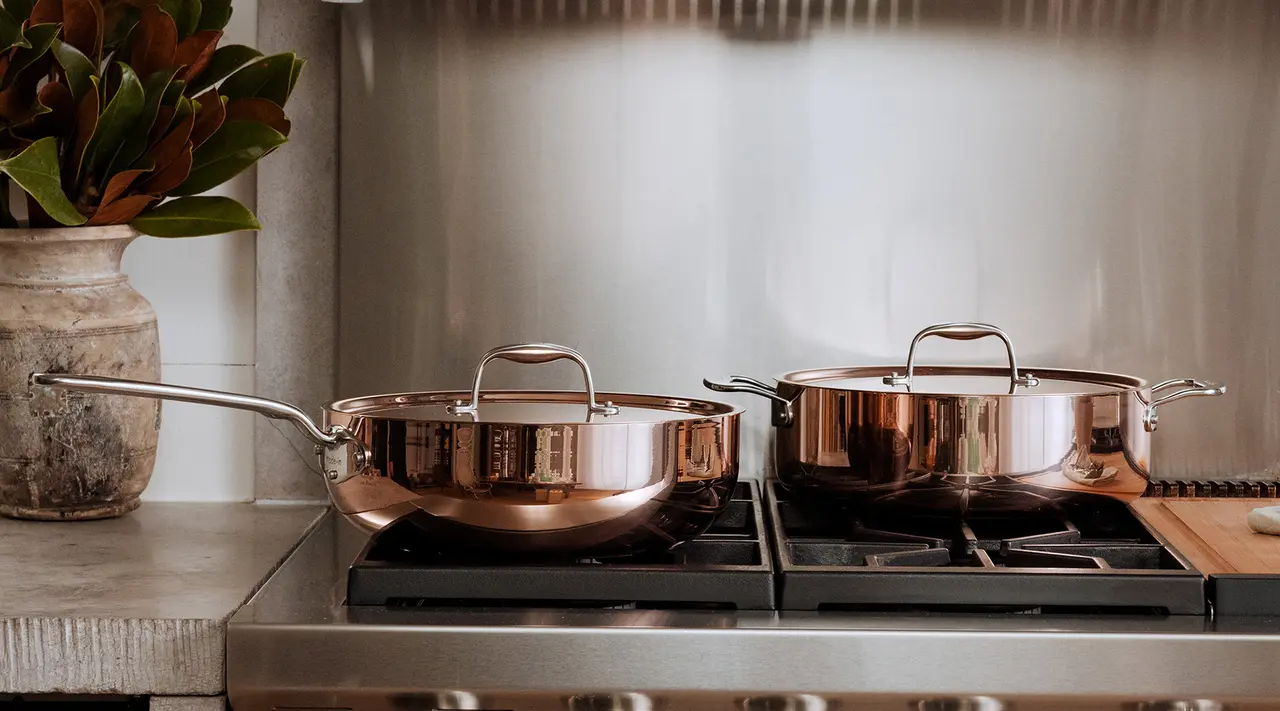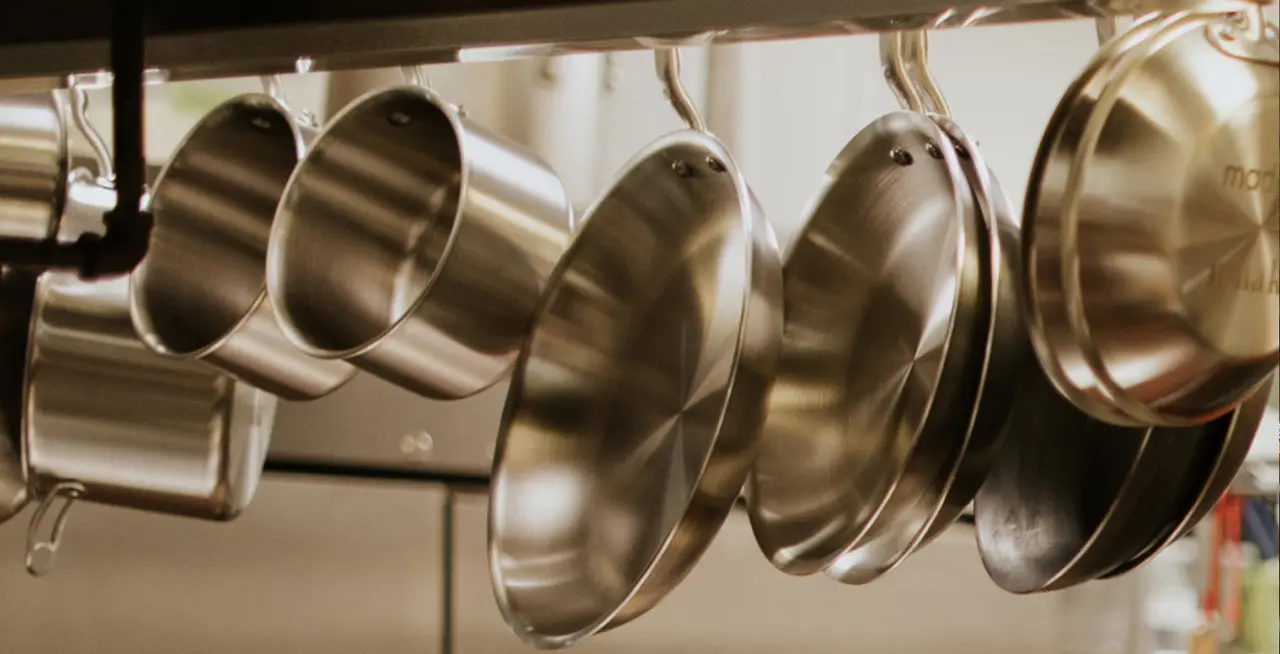When it comes to cookware material, copper and stainless steel are classic choices. But when choosing between the two, how do you know which to buy? While copper is timeless and likely to conjure images of a rustic French country house, stainless steel is a workhorse, the cookware of choice in professional kitchens.
At a glance, both materials have a place in your own kitchen and both are excellent at evenly conducting heat. Learn the differences between copper vs. stainless steel to decide which is best for you.
Understanding Copper Cookware

The biggest power of copper cookware lies in its ability to conduct heat: copper pots and pans heat up and cool down quickly, making them very attentive to every little nudge in temperature that you make. And if you’re looking for cookware that instantly adds glam to your kitchen, copper is the one.
Advantages of Copper Cookware
While we applaud stainless steel’s ability to heat up quickly, we give copper a standing ovation. It not only heats super fast, but also circulates that heat more evenly and, crucially, cools down quickly when you reduce the temps. This proves especially useful for making delicate foods like fish filets or caramel, when the last thing you want to do is overcook or burn.
Made in France, our Copper Collection’s stainless steel lining means you can use your pots and pans at high heat (compared to tin linings commonly found in other copper cookware). The stainless steel is also non reactive, meaning you don’t need to worry about cooking acidic ingredients (more on that below).
Limitations of Copper Cookware
You’ll find some copper pots without any lining or coating. Since copper is reactive by itself, if you’re cooking something acidic, this means copper can leach into your food. Will it harm you right away? No. But over time, copper will build up in your system and can lead to poisoning. (Ditto copper storage containers—use those for non edible things!)
Lined copper cookware creates a barrier between the copper and your food, making it much safer to work with. Tin is one common lining, but we vastly prefer stainless steel lining, which can be heated to high temperatures and cook any ingredient without worry.
Copper cookware isn’t cheap, but its ability to conduct heat is really what sets it apart and can make it worth the price—it may be better to think of it as an investment piece that pays off over time. As for cleaning, copper does require a bit more love and attention than stainless steel. But like any cleaning regimen, once you learn how to do it, this task won’t seem so overwhelming.
Understanding Stainless Steel Cookware

Where copper might compare to a BMW, stainless steel is a Subaru. Copper is a beautiful, well-made investment; stainless steel is the more affordable, dependable, crowd-pleasing workhorse. And while it can seem tricky to use stainless steel, you’ll quickly learn how easy it is to cook with.
Advantages of Stainless Steel Cookware
Stainless steel can do it all—even eggs and delicate fish—with a little practice. It’s also the ideal material to sear a steak, sauté vegetables, or pan-fry a crusty piece of bread. Since it’s non reactive, you can simmer acidic tomato sauces or deglaze the pan with vinegar without worry. Stainless steel is also very resistant to scratches and stains—and if you do burn something on, you can almost always restore it.
Limitations of Stainless Steel Cookware
Compared to copper, stainless steel has a lower heat conductivity. Depending on the brand, you’ll notice definite cold spots and uneven heating. Our 5-ply Stainless Clad construction means that heat evenly distributes, so hot spots won’t be an issue. It’s not quite as responsive to changes in temperature as copper, however. Stainless steel also retains heat for a bit longer than copper, so there might be a bit of a learning curve as you learn how quickly (or not) a pan will heat up and cool down when adjusting the temperature.
Copper and Stainless Steel: Which Is Better?

Like most matters of comparison, the question isn’t really “which is better,” but which works best for you. For copper versus stainless steel, there are three main factors to keep in mind: your cooking preferences, your kitchen space, and your budget.
Precision Cooking vs. Versatility
If it’s extreme precision you need, then copper is probably your speed. Copper is extremely good at conducting heat and electricity, which is why it’s such a valuable metal beyond cookware. Not only will it heat quickly, but as soon as you take it off the heat, copper cookware cools down just as fast.
Stainless steel—especially our Stainless Clad Collection—heats up very quickly, too. You’ll bring liquids to a boil and heat up cooking fat without breaking a sweat. Stainless steel retains heat a bit longer than copper, though, so the best option for you depends on which types of dishes you cook the most.
Aesthetics and Appearance
While a collection of shining stainless steel pots and pans is beautiful, copper cookware adds a certain rustic, refined charm. (But also, mixed metals as a design choice are in—you could always choose both.) When it comes to cleaning and maintaining each material, stainless steel is a little easier, especially with our Stainless Steel Cleaner.
Since copper is reactive, its appearance will change after every use, eventually developing a patina that can also lend its own rustic charm. If you prefer the gleaming original, though, routine polishing can maintain it. Read our guide to maintaining copper cookware to learn more.
Long-term Investment vs. Immediate Cost
There’s no denying that copper is expensive. Buying copper pans is definitely a long-term investment, but their versatility and durability mean it's an investment worth making. Stainless steel won’t set you back as much, and our Stainless Clad Collection is designed to withstand the heat of any kitchen.
Ready to Shop?
When it comes to copper versus stainless steel, both have their advantages. Which you choose depends on your kitchen, cooking style, and budget. Dive into our collections to see all the possibilities we offer, fit for any cook (and any kitchen).























